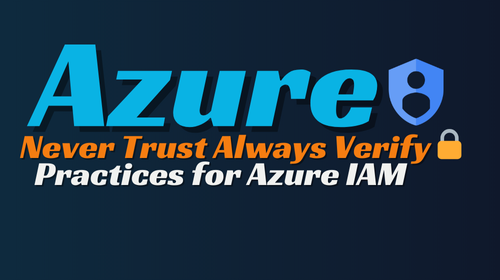- Home
- Security & Compliance
- Never Trust Always Verify Best Practices for Azure IAM 🔒
Never Trust Always Verify Best Practices for Azure IAM 🔒
Best Practices for Azure Identity Management and Access Control Security
In today’s digital landscape, protecting identities and controlling access to resources are paramount for ensuring the security of cloud environments. With Azure AD, now known as Microsoft Entra ID, organizations can implement robust identity management and access control solutions to safeguard their assets effectively. In this article, we’ll explore the best practices for Azure identity management and access control security, including recent updates and enhancements.

Azure Identity Management and Access Control Best Practices
Treat Identity as the Primary Security Perimeter 🔒:
- Emphasize identity as the first line of defense against cyber threats.
- Implement strong authentication mechanisms and enforce strict identity verification processes.
Centralize Identity Management 🔄:
- Consolidate identity management functions within Microsoft Entra ID to streamline administration and enhance security.
- Leverage features such as user provisioning, group management, and self-service password reset for centralized control.
Manage Connected Tenants 🏢:
- Maintain visibility and control over all connected tenants to ensure consistent security policies and practices.
- Implement cross-tenant governance and monitoring solutions to detect and mitigate potential risks.
Enable Single Sign-On (SSO) ➡️:
- Simplify user access and enhance user experience by enabling SSO across Azure and other integrated applications.
- Leverage Azure Active Directory Seamless Single Sign-On (Azure AD Seamless SSO) for seamless authentication without prompting for credentials.
Turn on Conditional Access 🚦:
- Implement conditional access policies to enforce adaptive access controls based on user context, device compliance, and location.
- Apply risk-based access policies to dynamically adjust access levels and protect sensitive resources.
Plan for Routine Security Improvements 🛡️:
- Regularly review and update security configurations to align with evolving threats and industry best practices.
- Conduct security assessments and penetration tests to identify vulnerabilities and prioritize remediation efforts.
Enable Password Management 🔐:
- Implement strong password policies and configure password protection features to prevent password-related attacks.
- Enable self-service password reset to empower users to reset their passwords securely without IT intervention.
Enforce Multifactor Verification for Users ✅:
- Require multifactor authentication (MFA) for all users to add an extra layer of security and prevent unauthorized access.
- Configure MFA settings to support various authentication methods, such as SMS, phone call, or authenticator app.
Use Role-Based Access Control (RBAC) 🛡️:
- Implement RBAC to control access to Azure resources based on predefined roles and permissions.
- Assign roles with the least privilege principle to limit access to only what is necessary for users’ job responsibilities.
Lower Exposure of Privileged Accounts 🕵️♂️:
- Minimize the number of privileged accounts and regularly review and monitor their activities.
- Implement just-in-time (JIT) access and time-bound access for privileged roles to reduce the exposure to potential threats.
Control Locations Where Resources Are Located 🌍:
- Implement Azure Policy to enforce geographic restrictions and control where resources can be deployed.
- Configure network security groups (NSGs) and virtual network (VNet) controls to restrict access based on IP address ranges and geographic locations.
Use Microsoft Entra ID for Storage Authentication 🔄:
- Utilize Microsoft Entra ID for secure authentication and access control to Azure storage resources.
- Leverage built-in security features such as encryption, access controls, and auditing to protect data at rest and in transit.
By following these best practices for Azure identity management and access control security, organizations can strengthen their security posture, mitigate risks, and protect their valuable assets from potential threats. With Microsoft Entra ID and its comprehensive security features, organizations can build a secure and resilient cloud environment to support their digital transformation initiatives.


Shashidhar B J
April 24, 2025Good info